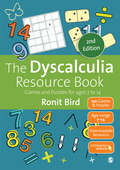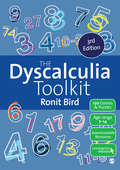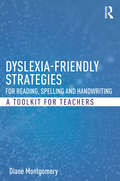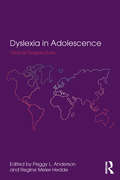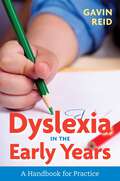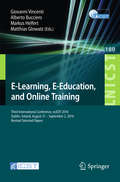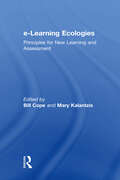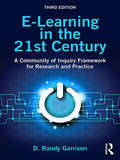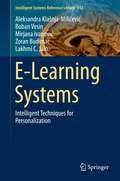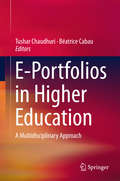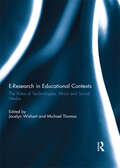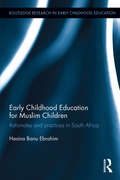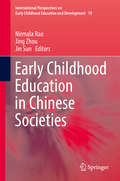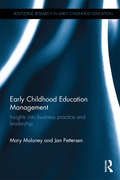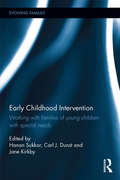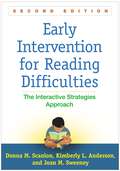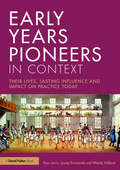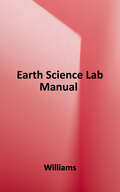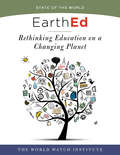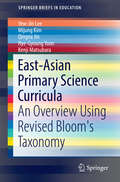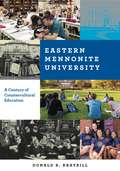- Table View
- List View
The Dyscalculia Resource Book: Games and Puzzles for ages 7 to 14
by Ronit BirdWritten by a teacher for teachers, the second edition of Ronit Bird’s The Dyscalculia Resource Book now comes with 120 games and puzzles and a brand new section on ‘mixed operations puzzles’ which require learners to switch mentally between addition, subtraction, multiplication and division. The new edition will also provide access to an accompanying website featuring demo videos of different games and puzzles and the option to easily download and print all the games and puzzles in the book! Ideal for working with students 7 to 14 years old, this is the perfect companion to The Dyscalculia Toolkit, essential additions to every teachers’ resource collection.
The Dyscalculia Resource Book: Games and Puzzles for ages 7 to 14
by Ronit BirdWritten by a teacher for teachers, the second edition of Ronit Bird’s The Dyscalculia Resource Book now comes with 120 games and puzzles and a brand new section on ‘mixed operations puzzles’ which require learners to switch mentally between addition, subtraction, multiplication and division. The new edition will also provide access to an accompanying website featuring demo videos of different games and puzzles and the option to easily download and print all the games and puzzles in the book! Ideal for working with students 7 to 14 years old, this is the perfect companion to The Dyscalculia Toolkit, essential additions to every teachers’ resource collection.
The Dyscalculia Toolkit: Supporting Learning Difficulties in Maths
by Ronit BirdThe new edition of the bestselling Dyscalculia Toolkit continues to meet the needs of specialist and non-specialist teachers working with learners aged 6 to 14 years, who have difficulty with maths and number. Now with over 200 activities and 50 games, new and improved illustrations, and an expanded list of recommended readings, useful websites & resources, the new edition also includes exclusive access to a brand new companion website which features; - 10 videos with over 45 minutes of material demonstrating a selection of games from every section - Editable pupil tracking sheets organised by teaching point and section - Over 70 pages of downloadable and printable teaching materials including activity sheets, game boards, teaching resources & summary tables. Packed full of practical, creative and innovative ideas and strategies this is the complete toolkit to help teachers and parents support learners with dyscalculia or those struggling with mathematics.
The Dyscalculia Toolkit: Supporting Learning Difficulties in Maths
by Ronit BirdThe new edition of the bestselling Dyscalculia Toolkit continues to meet the needs of specialist and non-specialist teachers working with learners aged 6 to 14 years, who have difficulty with maths and number. Now with over 200 activities and 50 games, new and improved illustrations, and an expanded list of recommended readings, useful websites & resources, the new edition also includes exclusive access to a brand new companion website which features; - 10 videos with over 45 minutes of material demonstrating a selection of games from every section - Editable pupil tracking sheets organised by teaching point and section - Over 70 pages of downloadable and printable teaching materials including activity sheets, game boards, teaching resources & summary tables. Packed full of practical, creative and innovative ideas and strategies this is the complete toolkit to help teachers and parents support learners with dyscalculia or those struggling with mathematics.
Dyslexia-friendly Strategies for Reading, Spelling and Handwriting: A Toolkit for Teachers
by Diane MontgomeryMany pupils with dyslexia have poor spelling and handwriting, even when their reading is adequate. This practical yet evidence-based book shows teachers who work with pupils with dyslexia how they can effectively address these areas of weakness. Diane Montgomery introduces her popular Cognitive Process Strategies for Spelling (CPSS) and provides guidance on how this direct action can be successfully used in both primary and secondary contexts. The book describes dyslexia-friendly approaches in Logographic, Alphabetic and Orthographic phases – ‘the three faces’ of dyslexia. Best literacy practice for all children is illustrated in a developmental reading and spelling approach, handwriting as a support to literacy teaching is explained and strategies for overcoming handwriting difficulties are detailed from Reception onwards. Dyslexia-friendly Strategies for Reading, Spelling and Handwriting is full of new research, case examples and practical methods that have been tried and tested in the classroom. This is a must-read guide for all teachers and SENCOs in primary and secondary settings working with pupils with dyslexia.
Dyslexia in Adolescence: Global Perspectives
by Peggy L. Anderson Regine Meier-HeddeDyslexia in Adolescence: Global Perspectives presents international case studies on the psychosocial development and academic progress of adolescents with dyslexia to enhance understanding of adjustment factors, outcomes and support. The continuation of a qualitative longitudinal research project that focused on children between ten and twelve years of age, this volume revisits them between ages fourteen and sixteen. Through semi-structured interviews, personal narratives, and other assessments, these case studies relate the trials and tribulations associated with the development of adolescents with dyslexia from around the world and the challenges that parents face in supporting their children.
Dyslexia in the Early Years: A Handbook for Practice
by Gavin ReidResearch has shown that early identification and intervention is crucial and can in fact minimise, and may even prevent, the challenges of dyslexia from becoming too detrimental at later stages of education. This book offers both research insights and practical guidance for teachers working in Early Years settings on how to create resource materials that would be suitable for the development of children with dyslexia. Beginning with a contextual note on the key difficulties faced by children at risk of dyslexia, the book takes the reader through the processes of identification and diagnosis, before offering ideas on how to tailor classroom materials for these students. The book's resource materials are designed to target areas such as reading, spelling, numeracy, language skills, social and emotional development, and problem solving skills.
E-Learning, E-Education, and Online Training
by Giovanni Vincenti Alberto Bucciero Markus Helfert Matthias GlowatzThis book constitutes the proceedings of the 3rd International Conference on E-Learning, E-Education, and Online Training, eLEOT 2016, held in Dublin, Ireland, August 31 - September 2, 2016. The 25 revised full papers presented were carefully reviewed and selected from 35 submissions. They focus on topics as augmented reality learning, blended learning, learning analytics, mobile learning, virtual learning environments.
e-Learning Ecologies: Principles for New Learning and Assessment
by Bill Cope Mary Kalantzise-Learning Ecologies explores transformations in the patterns of pedagogy that accompany e-learning—the use of computing devices that mediate or supplement the relationships between learners and teachers—to present and assess learnable content, to provide spaces where students do their work, and to mediate peer-to-peer interactions. Written by the members of the "new learning" research group, this textbook suggests that e-learning ecologies may play a key part in shifting the systems of modern education, even as technology itself is pedagogically neutral. The chapters in this book aim to create an analytical framework with which to differentiate those aspects of educational technology that reproduce old pedagogical relations from those that are genuinely innovative and generative of new kinds of learning. Featuring case studies from elementary schools, colleges, and universities on the practicalities of new learning environments, e-Learning Ecologies elucidates the role of new technologies of knowledge representation and communication in bringing about change to educational institutions.
E-Learning in the 21st Century: A Community of Inquiry Framework for Research and Practice
by D. Randy GarrisonThe third edition of E-Learning in the 21st Century provides a coherent, comprehensive, and empirically-based framework for understanding e-learning in higher education. Garrison draws on his decades of experience and extensive research in the field to explore technological, pedagogical, and organizational implications. The third edition has been fully updated throughout and includes new material on learning technologies, MOOCs, blended learning, leadership, and the importance and role of social connections in thinking and learning, highlighting the transformative and disruptive impact that e-learning has recently had on education.
E-Learning Systems
by Aleksandra Klašnja-Milićević Boban Vesin Mirjana Ivanović Zoran Budimac Lakhmi C. JainThis monograph provides a comprehensive research review of intelligent techniques for personalisation of e-learning systems. Special emphasis is given to intelligent tutoring systems as a particular class of e-learning systems, which support and improve the learning and teaching of domain-specific knowledge. A new approach to perform effective personalization based on Semantic web technologies achieved in a tutoring system is presented. This approach incorporates a recommender system based on collaborative tagging techniques that adapts to the interests and level of students' knowledge. These innovations are important contributions of this monograph. Theoretical models and techniques are illustrated on a real personalised tutoring system for teaching Java programming language. The monograph is directed to, students and researchers interested in the e-learning and personalization techniques.
E-Portfolios in Higher Education
by Tushar Chaudhuri Béatrice CabauThis book shares the collective experience of integrating electronic portfolios as assessment tools and as instruments for life-long learning in courses across various disciplines in higher education. It enables readers to trace the evolution of e-portfolios over the last ten years and to deal with the challenges faced by instructors and students when implementing e-portfolios in their respective courses. Further, the book suggests flexible ways of dealing with those challenges. It also highlights the relevance of electronic portfolios for the needs and demands of contemporary societies. As such, it speaks to a large target audience from a range of disciplines, roles and geographical contexts within the wider context of higher education in Asia and around the globe.
E-Research in Educational Contexts: The roles of technologies, ethics and social media
by Jocelyn Wishart and Michael ThomasThis book explores the impact of e-research in education and the opportunities presented by a new generation of research approaches and tools. ‘E-research’ is an umbrella term that encompasses all digital research methods used for data collection and analysis including those involving handheld mobile devices. This is a current concern as the emergence of online tools that enable people to collaborate, create, and share information has led to the widespread use of these new digital research methods. Indeed, new tools and technologies are emerging almost daily and are being taken up by researchers for their ease of data collection and analysis. As a result the book investigates the implications of how we conceptualise educational research in the digital age. In addressing a range of key themes, from the ethics of e-research to the relationships between researchers and participants, the book presents original studies from a variety of educational contexts where digital tools are being used, and should be of value to postgraduate students, academic researchers, and policy makers. This book was originally published as a special issue of the International Journal of Research & Method in Education.
Early Childhood Education for Muslim Children: Rationales and practices in South Africa (Routledge Research in Early Childhood Education)
by Hasina Banu EbrahimEarly Childhood Education for Muslim Children foregrounds the marginalised perspective of Muslim children aged three to five and examines how they are cared for and educated in centre-based provision in two provinces in post-apartheid South Africa. Both theological and social science perspectives are carefully interwoven to make sense of the construction of service provision for Muslims as a minority group in a secular democracy. This book uses a qualitative, reflexive approach to amplify the voices of mothers, managers and teachers as the community of agents who shape priorities for young children in the context of a rapidly transforming society. The research demonstrates that the quest to establish an appropriate care network and a sound educative environment for Muslim children is riddled with complexities, struggles and tensions. In the light of changes in the home-based network for early education, centre-based provision has become an important infrastructure for Muslim communities seeking one-stop academic and Islamic education. The internal struggles encountered in this form of provision include inequities in access, struggles to package an appropriate curriculum, and dealing with nurturance specific to the faith and for cultural formations supportive of citizenship. This book calls for critical engagement with issues of religious education in early childhood, social cohesion, formal systematic teacher education for Muslim teachers, curriculum development and parental support. It will contribute not only to the development of early education from an Islamic perspective, but will also demonstrate how to expand discourses and practices to deal with diversity and faith development in early years. As such, it will appeal to academics, researchers and postgraduate students in the fields of early childhood education, religious studies, race and ethnic studies, and childhood studies
Early Childhood Education in Chinese Societies
by Nirmala Rao Jing Zhou Jin SunThis book provides an up-to-date account of relevant early childhood policy and practice in five Chinese societies: the People's Republic of China or Mainland China, Hong Kong, Macao, Singapore, and Taiwan. It analyses how traditional Chinese values, Eastern and Western curricular approaches, and socio-political, economic, cultural and demographic changes influence current policies, services and practice. It addresses responses to global concerns about the excluded and disadvantaged, and about quality, and explains lessons from and for Chinese early childhood education. This book is the first English-language research-based review of early childhood education and the factors that affect it in different Chinese societies. It is particularly timely given the increased recognition of the importance of early childhood education for human capital development globally, and the international interest in understanding early education in Chinese societies. iv>
Early Childhood Education Management: Insights into business practice and leadership (Routledge Research in Early Childhood Education)
by Mary Moloney Jan PettersenThe Early Childhood Education sector around the world is constantly changing, whether because of the unprecedented demand for ECE services globally, accelerated social change, or the introduction of pedagogical and regulatory practices. Based upon empirical inquiry, Early Childhood Education Management examines the somewhat controversial concept of operating an early childhood service as a business. It challenges the assumption that an early childhood manager does not require specialist knowledge or skill and discusses which attributes an effective manager should possess. In this book, which brings together management theory and practice, Moloney and Pettersen address core issues at the heart of the management role, including the relationship between early childhood policy and broader legislative enactments, as well as issues related to the challenges and development of management skills. The book also draws upon real-life examples from practice in order to offer insight into some of the most common topics and challenges related to management practice in Early Childhood Education, such as business acumen and entrepreneurship, recruitment and selection, financial management and budgeting, supervision, mentoring, staff development, curriculum management, collaborative working, and change management. Written by leading academics with practice experience, the book should be of great interest to researchers, academics and postgraduate students in the field of education, specifically those working in early years and education policy and management. It should also be essential reading for managers working in Early Childhood settings.
Early Childhood Intervention: Working with Families of Young Children with Special Needs (Evolving Families)
by Hanan Sukkar Carl J. Dunst Jane KirkbyEarly childhood is considered a critical but often vulnerable period in a child’s development where early identification and intervention can be crucial for improving children’s developmental outcomes. Systems and family-centred perspectives are vital to support families and build their capacities to lead normalized lives with improved family quality of life. This book explores the family-centred practices and systems factors which influence families’ experiences raising children with complex needs. It also considers the ways in which professionals can work with families to build and support parent and child competence. Conceptual and practical work from Australia, Canada, Europe and the United States present descriptions of and implications for different family system frameworks and early-childhood programs. Contributors in this edited volume bring together contemporary information that bridges the research to practice gap in supporting families of young children with disabilities or delays. Chapters include: Early Intervention for Young Children with Developmental Delays: Contributions of the Developmental Systems Approach Family Composition and Family Needs in Australia: What Makes a Family? Working with Families in Early Childhood Intervention: Family-Centred Practices in an Individualised Funding Landscape Family Systems and Family-Centred Intervention Practices in Portugal and Spain: Iberian Reflections on Early Childhood Intervention This book will attract the attention scholars of Parenting and Families; Child Development and Childcare.
Early Intervention for Reading Difficulties: The Interactive Strategies Approach
by Donna Scanlon Kimberly Anderson Joan SweeneyGrounded in a strong evidence base, this indispensable practitioner guide and text has given thousands of teachers tools to support the literacy growth of beginning and struggling readers in grades K-2. The interactive strategies approach (ISA) is organized around core instructional goals related to enhancing word learning and comprehension of text. The book provides guidance for assessment and instruction in whole-class, small-group, and one-to-one settings, using the curricular materials teachers already have.
Early Years Pioneers in Context: Their lives, lasting influence and impact on practice today
by Pam Jarvis Wendy Holland Louise SwiniarskiThis accessible text provides an international study of critical educational leaders who established the foundation for Early Childhood Education across continents in the 19th and early 20th centuries. It places each pioneer within the time and culture in which they lived to help the reader understand how theories and knowledge about early years education and care have evolved over time. Early Years Pioneers in Context traces key themes such as play, child-initiated learning, working with parents, scaffolding children’s learning and the environment, enabling students to reflect on the differences and similarities between the pioneers and understand their contribution to practice today. Pioneers covered include: Frederick Froebel; Elizabeth Peabody; Susan Blow; Rudolf Steiner; Margaret McMillan; Maria Montessori Susan Isaacs; Loris Malaguzzi. Featuring student integration tasks to help the reader link key ideas to their own practice, this will be essential reading for early years students on undergraduate and postgraduate degree courses.
Earth Science Laboratory Manual
by Harry Williams Kent McGregor Ken Iles George Maxey Lisa Nagaoka Alexandra Ponette-GonzalezThis Earth Science Laboratory Manual is meant to supplement and reinforce lecture material by giving you an opportunity to apply what you learn in class through hands-on activities. <p><p>The exercises illustrate some of the fundamental principles of earth science using a mixture of hypothetical data sets, data from scientific publications and data collected locally from the North Texas region. The exercises emphasize a hands-on, quantitative approach, supplemented by a web-based virtual field trips and CD-ROM exercises.
EarthEd: Rethinking Education on a Changing Planet (State of the World)
by The Worldwatch InstituteEarth education is traditionally confined to specific topics: ecoliteracy, outdoor education, environmental science. But in the coming century, on track to be the warmest in human history, every aspect of human life will be affected by our changing planet. Emerging diseases, food shortages, drought, and waterlogged cities are just some of the unprecedented challenges that today's students will face. How do we prepare 9.5 billion people for life in the Anthropocene, to thrive in this uncharted and more chaotic future?Answers are being developed in universities, preschools, professional schools, and even prisons around the world. In the latest volume of State of the World, a diverse group of education experts share innovative approaches to teaching and learning in a new era. Topics include systems thinking for kids; the importance of play in early education; social emotional learning; comprehensive sexuality education; indigenous knowledge; sustainable business; medical training to treat the whole person; teaching law in the Anthropocene; and more.EarthEd addresses schooling at all levels of development, from preschool to professional. Its lessons can inform teachers, policy makers, school administrators, community leaders, parents, and students alike. And its vision will inspire anyone who wants to prepare students not only for the storms ahead but to become the next generation of sustainability leaders.
East-Asian Primary Science Curricula
by Yew-Jin Lee Mijung Kim Qingna Jin Hye-Gyoung Yoon Kenji MatsubaraThis book describes a comparative study of the primary science learning objectives (from the cognitive domain) in the curriculum of six high-achieving East Asian states -- mainland China, Hong Kong, Taiwan, Korea, Japan and Singapore. Specifically, the authors use one of the most widely accepted and useful tools in curriculum research -- revised Bloom's Taxonomy. This is the first time that such findings from all six states have been published in one place and the results are valuable for policymakers, educators and researchers around the globe. Our new English translations of the primary science learning objectives in China, Taiwan and Korea will also greatly facilitate future analyses of these curricula.
Eastern Mennonite University: A Century of Countercultural Education
by Donald B. KraybillIn this unique educational history, Donald B. Kraybill traces the sociocultural transformation of Eastern Mennonite University from a fledgling separatist school founded by white, rural, Germanic Mennonites into a world-engaged institution populated by many faith traditions, cultures, and nationalities.The founding of Eastern Mennonite School, later Eastern Mennonite University, in 1917 came at a pivotal time for the Mennonite community. Industrialization and scientific discovery were rapidly changing the world, and the increasing availability of secular education offered tempting alternatives that threatened the Mennonite way of life. In response, the Eastern Mennonites founded a school that would “uphold the principles of plainness and simplicity,” where youth could learn the Bible and develop skills that would help advance the church. In the latter half of the twentieth century, the university’s identity evolved from separatism to social engagement in the face of churning moral tides and accelerating technology. EMU now defines its mission in terms of service, peacebuilding, and community.Comprehensive and well told by a leading scholar of Anabaptist and Pietist studies, this social history of Eastern Mennonite University reveals how the school has mediated modernity while remaining consistently Mennonite. A must-have for anyone affiliated with EMU, it will appeal especially to sociologists and historians of Anabaptist and Pietist studies and higher education.
Eastern Mennonite University: A Century of Countercultural Education
by Donald B. KraybillIn this unique educational history, Donald B. Kraybill traces the sociocultural transformation of Eastern Mennonite University from a fledgling separatist school founded by white, rural, Germanic Mennonites into a world-engaged institution populated by many faith traditions, cultures, and nationalities.The founding of Eastern Mennonite School, later Eastern Mennonite University, in 1917 came at a pivotal time for the Mennonite community. Industrialization and scientific discovery were rapidly changing the world, and the increasing availability of secular education offered tempting alternatives that threatened the Mennonite way of life. In response, the Eastern Mennonites founded a school that would “uphold the principles of plainness and simplicity,” where youth could learn the Bible and develop skills that would help advance the church. In the latter half of the twentieth century, the university’s identity evolved from separatism to social engagement in the face of churning moral tides and accelerating technology. EMU now defines its mission in terms of service, peacebuilding, and community.Comprehensive and well told by a leading scholar of Anabaptist and Pietist studies, this social history of Eastern Mennonite University reveals how the school has mediated modernity while remaining consistently Mennonite. A must-have for anyone affiliated with EMU, it will appeal especially to sociologists and historians of Anabaptist and Pietist studies and higher education.
Easy Electronics
by Charles PlattThis is the simplest, quickest, least technical, most affordable introduction to basic electronics. No tools are necessary--not even a screwdriver. Easy Electronics should satisfy anyone who has felt frustrated by entry-level books that are not as clear and simple as they are supposed to be.Brilliantly clear graphics will take you step by step through 12 basic projects, none of which should take more than half an hour. Using alligator clips to connect components, you see and hear immediateresults. The hands-on approach is fun and intriguing, especially for family members exploring the projects together.The 12 experiments will introduce you to switches, resistors, capacitors, transistors, phototransistors, LEDs, audio transducers, and a silicon chip. You'll even learn how to read schematics by comparing them with the circuits that you build.No prior knowledge is required, and no math is involved. You learn by seeing, hearing, and touching. By the end of Experiment 12, you may be eager to move on to a more detailed book. Easy Electronics will function perfectly as a prequel to the same author's bestseller, Make: Electronics.All the components listed in the book are inexpensive and readily available from online sellers. A very affordable kit has been developed in conjunction with the book to eliminate the chore of shopping for separate parts. A QR code inside the book will take you to the vendor's web site. Concepts include: Transistor as a switch or an amplifier; Phototransistor to function as an alarm; Capacitor to store and release electricity; Transducer to create sounds from a timer; Resistor codes; A miniature light bulb to display voltage; The inner workings of a switch; Using batteries and resistors in series and parallel; Creating sounds by the pressure of your finger; Making a matchbox that beeps when you touch it; And more. Grab your copy and start experimenting!
